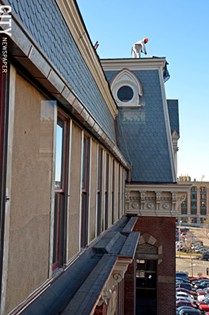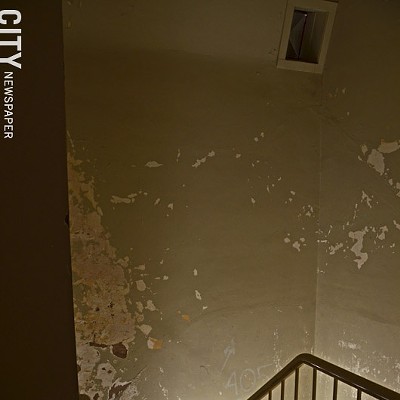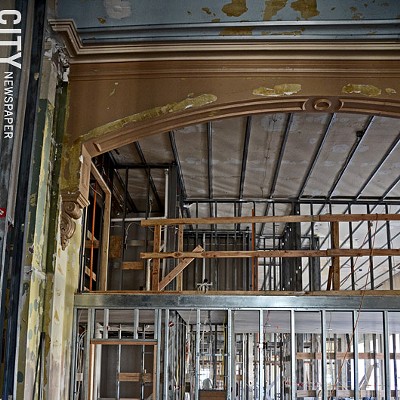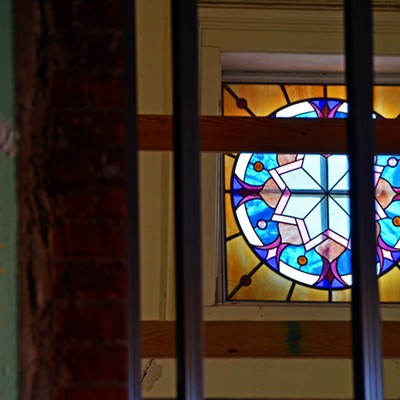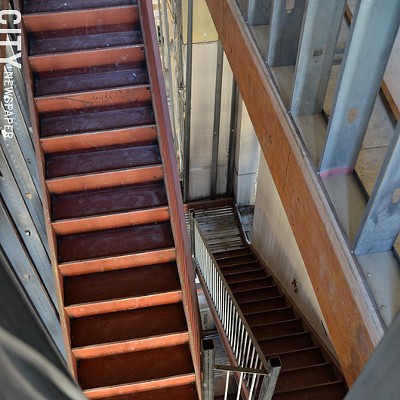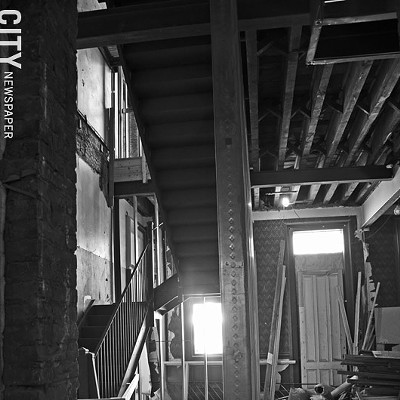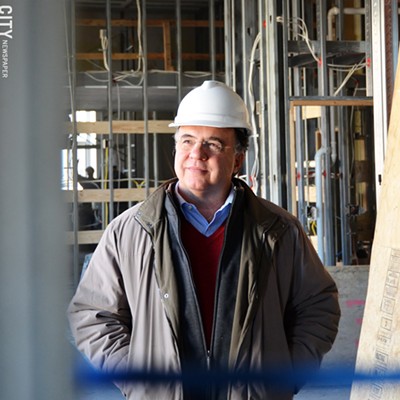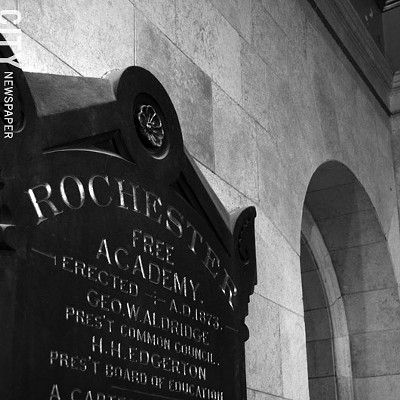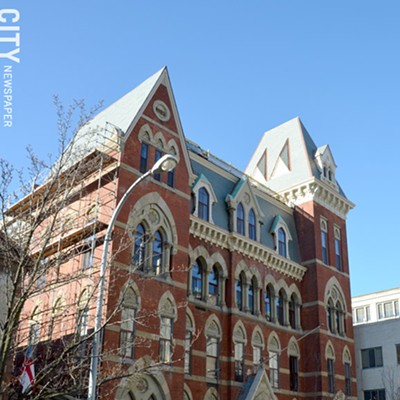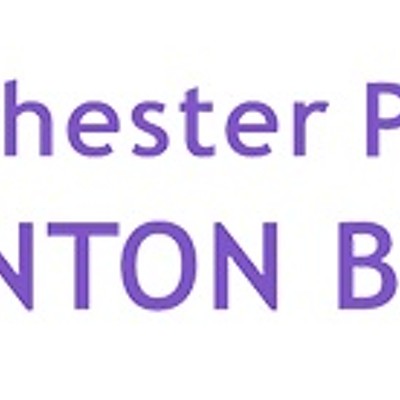[
{
"name": "500x250 Ad",
"insertPoint": "5",
"component": "15667920",
"parentWrapperClass": "",
"requiredCountToDisplay": "1"
}
]
The four-story building at 13 South Fitzhugh Street is alive with activity as construction workers in hard hats and dusty dungarees file in and out of the front entry. Some workers haul materials up to the roof, while others caulk the ground-floor windows. Just inside the chain-link fence that guards the building's perimeter stands a rusting blue sign:
"Pioneer School. First schoolhouse in Rochester was built of wood on this site. It was replaced by a two-story stone building in 1836, and then this structure in 1873 — State Education Department."
With its pointed windows and doors and steep roofline, Rochester's Free Academy Building is one of the city's best examples of High Victorian Gothic architecture. The style is reminiscent of medieval European churches and castles. Instead of using paint to create color variations, different shades of building materials were used to give the style a polychrome look.
The Academy Building has been prominently featured in numerous books and articles covering Rochester's history. The building has had several incarnations: the city's first high school, a municipal court, and home to the Rochester school board.
More recently, the basement housed the Edwards restaurant. Remnants of the restaurant's tin ceiling, painted dark green, can still be seen in one room.
After sitting vacant for years, the historic Academy Building is undergoing a major, $7 million transformation by owner and Florida developer George Traikos.
In early 2013 the building will be commissioned into service as a mix of retail and residential space. It will have 21 market-rate apartments ranging from one to three-bedroom units, Traikos says.
The apartments, which start on the second floor, have been custom-designed to take advantage of some of the building's unusual original features — 18-foot-high ceilings, crown molding (even in the hallways and stairwells), and in some instances, stained-glass windows. Each unit will have a washer and dryer, a powder room, tiled bathrooms, and wood floors, Traikos says.
The first floor will be devoted to retail and dining with outdoor seating.
"We started construction from the outside in, and from the top down," Traikos says.
Replacing the roof, complete with slate shingles, new gutters, and copper flashing cost $750,000.
Traikos, who has developed properties in Fort Lauderdale and Miami, had never set foot in Rochester and knew little about the area. But in 2006, an e-mail from a real estate broker grabbed his attention.
"It said this historic building in downtown Rochester was for sale for $750,000 and there was a 10-percent price reduction," he says. "That's the price of a one-bedroom condo in Miami Beach."
After a long conversation with the broker about Rochester's downtown and the property's not-so-great condition, Traikos said he gained a better understanding of the asking price.
Undeterred, Traikos came to Rochester and, he says, immediately fell head over heels for the Academy Building.
"I felt drawn to it," he says. "Like I had to do this."
But Traikos says he didn't expect the major hurdle that followed: getting financing. The construction industry was hit especially hard when the financial and housing markets crashed. Banks were not readily lending money, and many developers were stuck with inventory they couldn't sell because buyers couldn't get loans. Others couldn't get the money needed to complete projects they had in the pipeline.
Traikos was part of the last group.
"I never thought it was going to take six years to get a loan," he says. "That's been by far the most difficult part of this."
Traikos was able to secure financing by cobbling together a nearly $7 million loan package through the Community Preservation Corp., Fitzhugh Associates, and the State of New York Mortgage Agency. The building, which is listed on the National Register of Historic Places, was eligible for state and federal tax credits that could be applied against the cost of some of the renovations.
The City of Rochester also helped Traikos by securing a Restore New York grant.
"I have dealt with a lot of municipalities, but I have never ever dealt with a city that I've found to be so proactive and willing to help," Traikos says. "I was pleasantly shocked."
Traikos says the combination of tax credits and grants made the deal possible, and that those tools are critically important to both city officials and developers interested in restoring historic buildings.
"The truth is historic value has a historic cost," he says. "I couldn't have done this any other way."
Traikos is among a group of people including city leaders, preservationists, and developers supporting Senator Charles Schumer's effort to extend the New Markets Tax Credit, which is about to expire, and to pass a revised version of the Creating American Prosperity through Preservation Act.
The CAPP Act, which has helped repurpose dozens of old and often vacant office and manufacturing buildings, would increase the Historic Tax Credit from 20 percent to 30 percent. Vacant buildings often attract crime and repel new business development.
Neither of the tax-credit bills has been passed into law, and their fate is a uncertain in light of the financial discussions under way in Washington, DC.
But securing financing was not Traikos' only big hurdle. Renovating a building that's more than 100 years old typically requires all new electrical, plumbing, and heating and air systems.
"Plumbing has to be run through these gigantic floor joists, and frankly it's not an easy thing to do," Traikos says. "All this adds to the costs."
And even though the building is structurally sound, Traikos says, damage from neglected repairs had to be addressed right away.
"There was some water damage from old roof leaks," he says. "But we've been able to get to [that] in time. The situation might be different if this building had to sit [vacant] through a couple of more winters. Once water gets down into the walls and freezes, it expands."
Traikos is upbeat on downtown development. He says he looked closely at downtown Rochester's growth potential prior to purchasing the Academy Building, and he's convinced the much-awaited rebirth is here.
While it's true that much of downtown closes up after normal working hours, Traikos says many cities have a similar challenge. Rochester has an advantage, he says, because thousands of people come downtown to work.
"There is opportunity here," Traikos says. "We need to do more to entertain them and give them a reason to stay."
Speaking of...
-

Feedback 7/24
Jul 24, 2019 -

Mayor seeking funds for Parcel 5 project
Jul 17, 2019 -
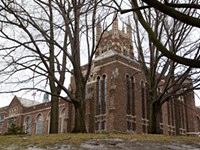
Colgate's south lawn will remain undeveloped, revised plan says
Jul 1, 2019 - More »
Latest in News
More by Tim Louis Macaluso
-

RCSD financial crisis builds
Sep 23, 2019 -

RCSD facing spending concerns
Sep 20, 2019 -

Education forum tomorrow night for downtown residents
Sep 17, 2019 - More »

